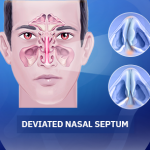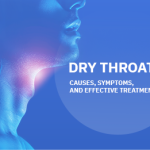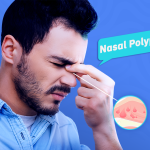Epistaxis
Epistaxis, or nosebleed, is a common condition affecting individuals of all ages for various reasons. According to medical research, approximately 60% of people worldwide have experienced a nosebleed at least once in their lives, yet only 10% of these cases require medical attention.
Epistaxis occurs due to bleeding from the tissues lining the inside of the nose, and it may come from one or both nostrils. This condition affects both children—especially those aged 2 to 10 years—and adults between the ages of 45 and 80. While nosebleeds can be distressing, most cases are not serious.
- Causes of Epistaxis
- What’s the Link Between Weather and Epistaxis?
- Types of Epistaxis
- Symptoms of Epistaxis
- Diagnosis of Epistaxis
- Treatment of Epistaxis
- How to Prevent Epistaxis
Causes of Epistaxis:
Some individuals may experience bleeding from one nostril, while others may have it from both—this is more common. Among the frequent causes of epistaxis:
Repeated sneezing
Foreign objects entering the nose
High blood pressure during sleep
Prolonged sun exposure
Cold or dry air, particularly in winter
Exposure to irritating chemicals
Facial trauma or accidents
Use of heaters during winter, which dry out the air
Certain medications such as decongestants and antihistamines
Sinus infections
Colds and allergies
Low platelet count, vascular inflammation, and capillary dilation
Vascular diseases like sudden high blood pressure with heart, lung, or liver complications
Sleep apnea
Less common causes include:
Pregnancy
Leukemia
Menstrual cycle
Elevated body temperature
Intense physical exertion
Nasal or facial surgeries
Vitamin deficiencies, especially vitamin C
What’s the Link Between Weather and Epistaxis?
Experts confirm that changes in temperature—whether hot or cold—can irritate the nasal passages and dry out the mucous membranes, leading to epistaxis. Proper hydration and nasal hygiene help reduce the risk of nosebleeds.
Types of Epistaxis:
There are two types of epistaxis:
Anterior Epistaxis:
Bleeding occurs from the front part of the nose due to rupture of surface blood vessels. This type is most common among children and often caused by minor trauma or injury.
Posterior Epistaxis:
Bleeding originates from deeper within the nasal cavity, affecting blood vessels near the throat. This form tends to be more severe, affecting adults and usually requiring urgent medical care.
Symptoms of Epistaxis:
Nosebleeds may occur suddenly, without warning, but can be accompanied by:
Headache
Tinnitus (ringing in the ears)
Dizziness or lightheadedness
Diagnosis of Epistaxis:
Diagnosis begins with a clinical examination by an ENT specialist to ensure no foreign object is present. The doctor will also ask about the patient’s medical history and may order:
Complete blood count (CBC) to detect blood disorders
Imaging tests like X-rays or CT scans of the nose and face
Blood pressure and heart rate monitoring
Treatment of Epistaxis:
Before treating a nosebleed, it is important to assess the amount and duration of bleeding. If bleeding lasts between 10 to 15 minutes, it typically resolves with home care. However, if it exceeds 20 minutes, immediate medical attention is advised.
Home treatment includes:
Wiping blood with a cloth or tissue
Avoiding lying down to prevent swallowing blood, which can irritate the stomach
Applying a cold compress on the nose
Pinching the nostrils forward and applying pressure with gauze for 10 minutes
Using nasal decongestant spray to constrict blood vessels
Avoiding bending backward, heavy lifting, or physical exertion for a few days
Medical treatments vary based on the cause and severity:
Removal of foreign objects by the doctor
Applying gauze or cotton to compress bleeding vessels
Cauterization of nasal blood vessels for recurrent bleeding
Surgery to ligate arteries near the bleeding site
How to Prevent Epistaxis:
To prevent epistaxis, follow these recommendations:
Maintain good home ventilation and avoid dry air
Avoid aspirin unless prescribed
Keep nasal passages moist with saline sprays or humidifiers
Protect the nose from foreign bodies or trauma
Though epistaxis is generally not dangerous, it should not be ignored if it occurs for more than 20 minutes a day. In such cases, medical consultation is essential to avoid possible complications like:
Swallowing blood, leading to nausea or vomiting
Significant blood loss
Anemia due to repeated or heavy bleeding
